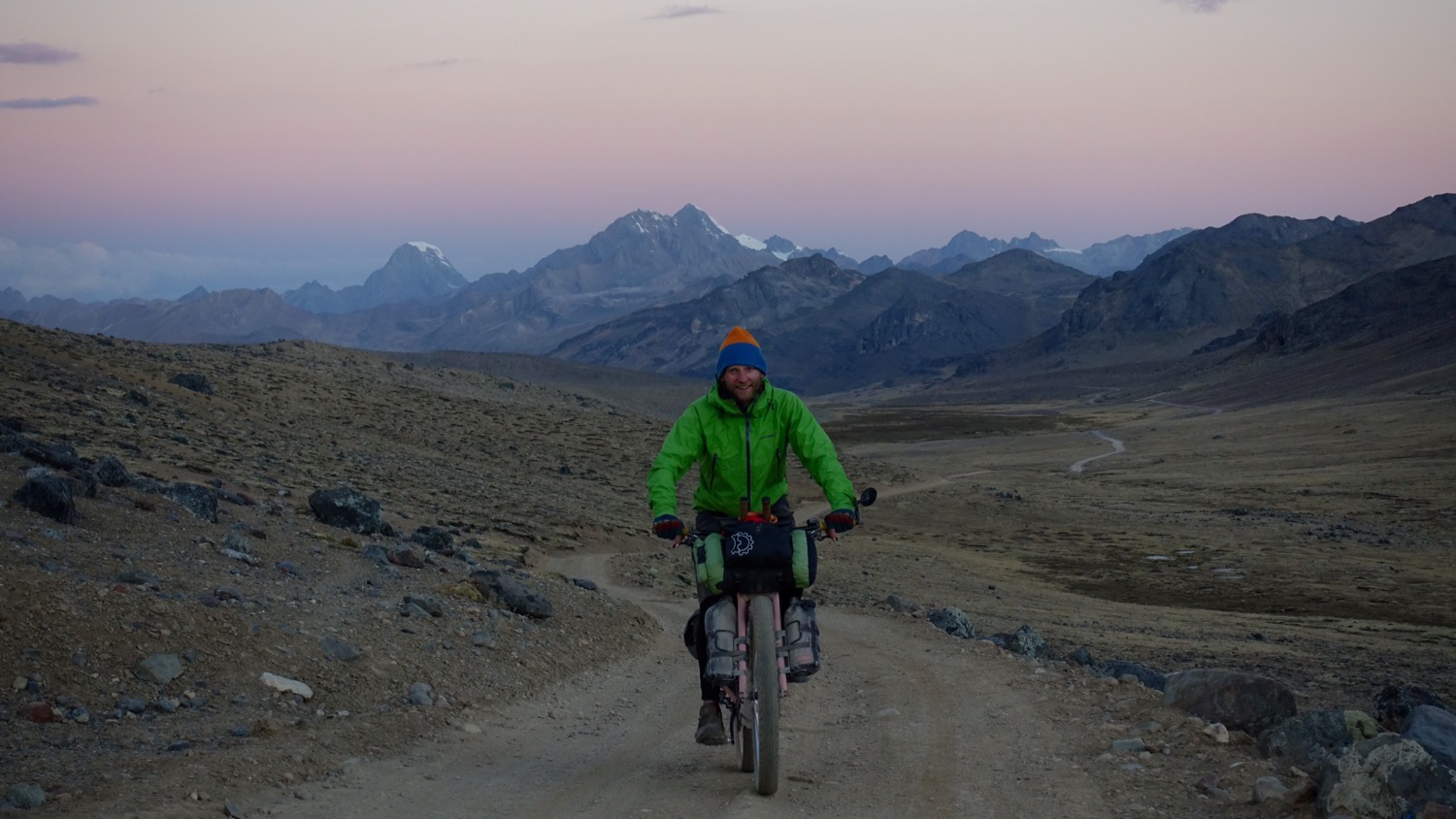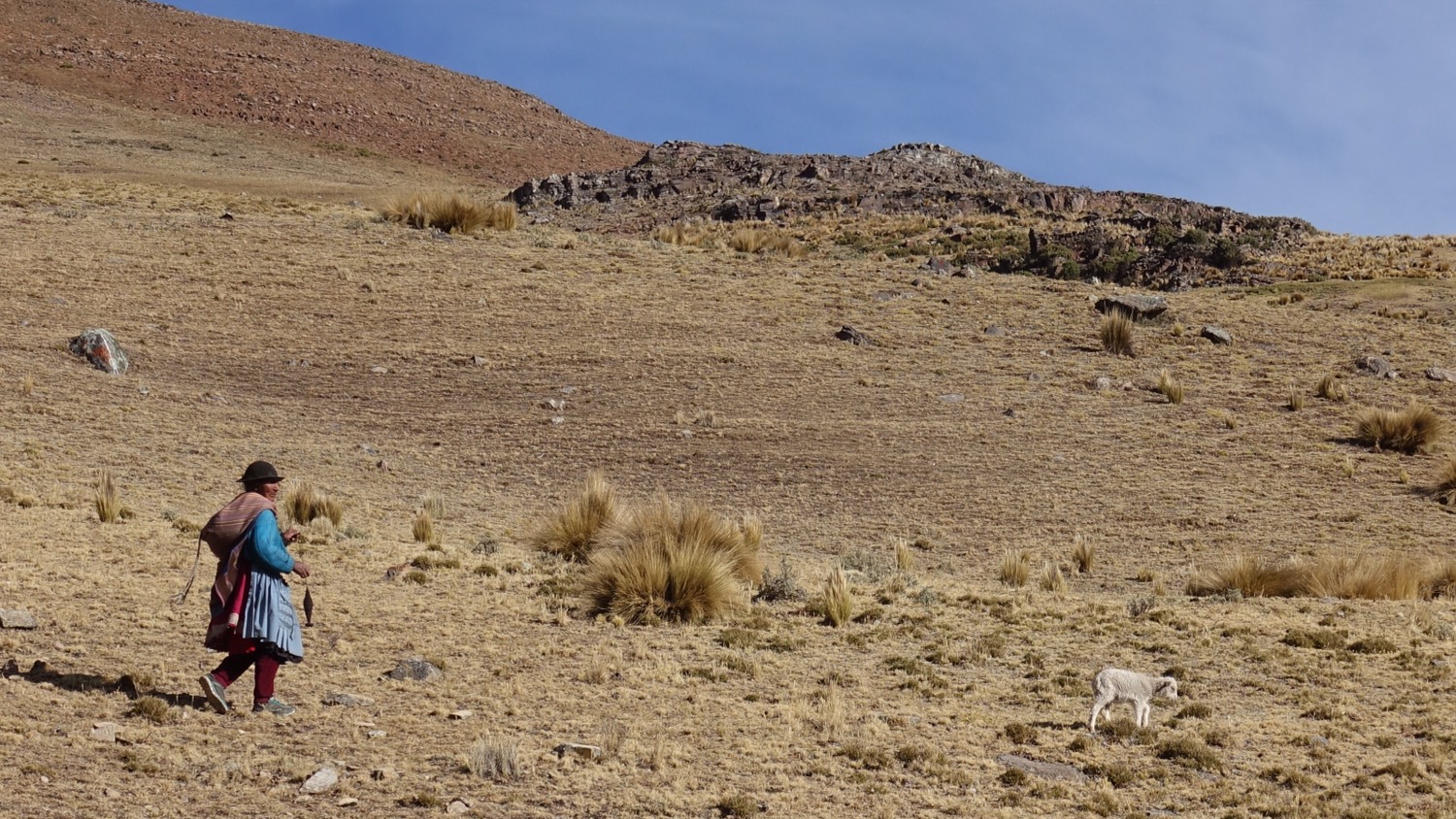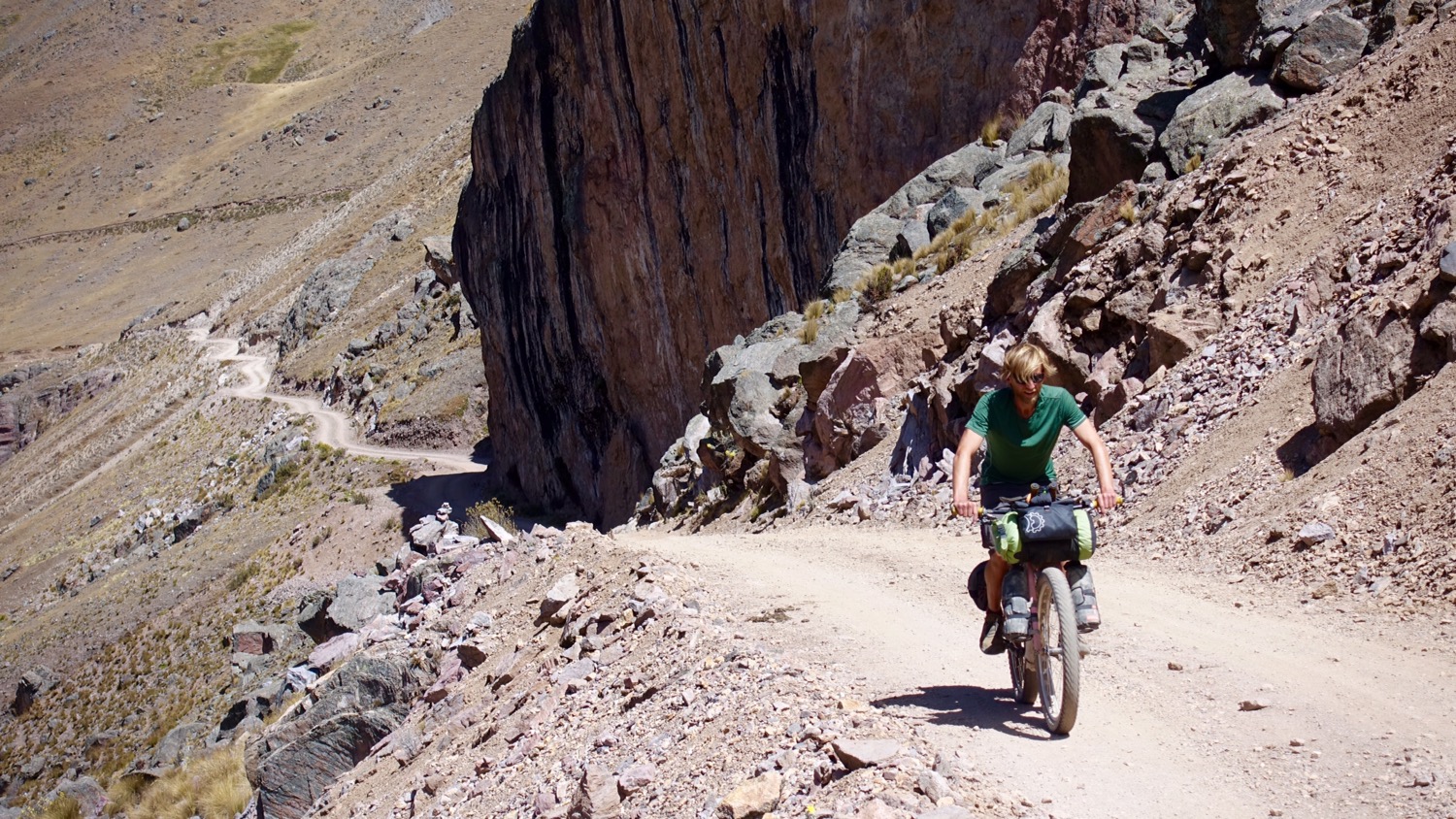No!
Yes!!
no!!!
yes!!!!
no !!!!!
yes !!!!!!
-Steeled black-rimmed eyes and sour expressions from both sides.
This is how the communication between 2 grown men and a woman played out, at a bus station in a tiny Peruvian village, at 5 in the morning.
We had bought a ticket for the night bus from Cusco to Ayacucho, so that we could get to the start of one of the bikepacking tracks we had been looking forward to the most.
Already a year ago, at home on the soft sofa in Copenhagen, we had found this gem of a beautiful track, The Peru Divide Trail, which led the hard-working rider through some of the most remote and beautiful landscape in Peru. And not least, over some of the highest passes in the mighty Andes. Lots of climbing and lots of steep descents awaited us.
But now we had been thrown off the night bus that we thought would take us all the way. The other, local, passengers on the night bus were already well settled and half asleep in the other autobus, which was to take us the last distance.
But the two morning-pale Danes, who hadn't quite grasped what was happening, were now standing and discussing with the driver, who was on the roof of the small autobus. He refused to have to carry two large bicycles on top of the huge load of parcels that had already found their way onto the roof of the small vehicle.
We stood on the ground clutching our beloved bikes until our knuckles were completely white while insisting in broken Spanish that he should take us and the bikes with him.
Quite obsessed, it was enough to tighten it, to throw the two bikes on the roof, but at 5 o'clock in the morning in an empty city, with a view of... nothing... we were quite convincing that the two bikes weighed or filled almost nothing.
The whole ordeal ended with a little support from the ticket inspector from the night bus, who had to admit that we had tickets and therefore had to go. So the bikes were thrown onto the roof, tied down with a bit of rope, and we were squeezed between the half-asleep Peruvians in the small bus. We crossed our fingers that the bikes would stay on the roof, and went out into the morning light, which peeked out between the mountains.
On this slightly crooked leg, the otherwise absolutely fantastic trip we had over 8 days, across the ridge of the Andes started. Also called the Peru Divide.
The Peru Divide Trail is 350 km and 8700 meters of altitude. There are many bikepackers who go up in it. It takes a few meters of altitude. We really care most about whether the trail is beautiful and fun to ride. And we had to get plenty of both. It turned out to be the most beautiful cycling we have done in Peru…
From Ayacucho we had to take another bus to get to Huancavelica, where the trail started. This time it went without drama.
In Huancavelica we suddenly experienced a completely different Peru. We'd had a few bad experiences in the past, and although we'd also met a lot of nice people, Peru hadn't quite gotten under our skin yet. But here in Huancavelica we now experienced a sincerity and a kindness that warmed. And you could see that it was a city where people made an effort and were proud. It was really nice here. The trees were cut into small shapes and there were lots of beautifully landscaped sidewalks. Not like at home, where you think that the gray stones lie beautifully in a straight line, but in such a way that you have laid beautiful tiles in beautiful patterns. Real craftsmanship, which has required time and aesthetic sense.
Also in Huancavelica, we met the teachers who are striking for better conditions. This time we were standing in the town plaza when a demonstration came around the corner. It only took a moment before someone had the bright idea to pour gasoline on a couple of car tires and set them on fire, prompting the attending combat-suited officers to rush across the square. We did not see the end of that escalation when we chose to evaporate and leave the teachers to deal with their problems themselves.
Thus already filled with whimsical experiences, and with an open mind, we headed out of town, into the mountains, onto The Peru Divide Trail.
Our faithful spectators for the next several days would quickly turn out to be the Alpacas. The llama's cousin. An overgrown sheep with a long neck, if you will. A woolly animal that is equal parts curious, equal parts scared. Maybe just confused. As a rule, they stand quite calmly at the side of the road, or on the road, and look for us when we come cycling. Right until we're very close. Then they think that maybe we could be dangerous and then the hell gets to them and they panic and run in some random direction. Preferably up the steepest rock wall they can find. But even if they're a little crazy, it's hard not to like them.
Although we quickly leave civilization and feel far away from everything and everyone and far out in the countryside, we find that we are never alone. There is always someone living in a tiny little house out in the middle of nowhere. On a slope. On top of a rock block. Some wild place. And the animals that we see around are always owned by someone, so eventually it becomes a sport when you spot a herd of animals, whether you can spot the one who looks after them. It is not always easy. But you usually have to look for a big, nice, colorful dress, hidden in the shade behind a big rock.
Occasionally we also pass houses close to the road. And in such a place, where the road made a bend, an elderly lady called out to us as we cycled past. We turned around and talked to her a bit. She said she had chest pains and asked if we had any medicine she could get. We had to regret that. She then asked if we could not bring medicine back to her, from the next town (which was probably 7-8 days away). We tried to explain as best we could in broken Spanish that we would not be coming back. That we were on a long trip, to Alaska. But it was as if she never fully understood the long trip, and could not relate to having to go further than just the immediate area. However, we were told that we were not coming back.
She lived, like most others in the area, in a small house, built of blocks of dried clay filled with straw. The roof is made of straw or corrugated iron. The door is made of wood or tin. And there are no windows. We see a lot of these kinds of houses. They are beautiful. And they are definitely sustainable. They don't cost much to build other than the time you have to spend on it. In these times when architects are working more and more with sustainability and indoor climate, there is something really beautiful about seeing these completely traditional houses.
But even though it is easy to romanticize country life, the simple life, the lady showed us very clearly the reverse side of it. She does not have access to medicine or a doctor without having to travel for several days. There are many of the necessities we take for granted that are a distant luxury to many others in this world.
And we also got to feel that ourselves when we once again got a stomach ache. As a long-distance cyclist, there are two very favorite topics of conversation, which are connected at opposite ends, as they say. One topic is food. The second is how it comes out again. Because, as Tim our cycling friend says, you are never one hundred percent healthy.
And this time, when we were a third of the way into the route, far away from the nearest doctor, we got Banana Pancake. And no - I'm not talking about a delicious dessert. That's how it comes out again. Banana Pancake was a term Morgane (French cycling friend) coined when she was getting tired of hearing about yellow slimy poo.
Well - but there is no doubt that we had something going for us. And it could also be felt in the strength for a few days. We had various options to cut the trip short and drive down to a doctor, which we discussed over the next few days.
In the meantime we scaled a few more high passes. We started taking pictures of those above 4000m at the top. It turned out quite a bit. Over the entire route of 350km, we drove 8 passes over 4000m. And in total we drove 8700 meters of altitude.
But it was always the beautiful landscape that impressed us the most. The colors the mountains have here are indescribable. A mountain lake where a snowy mountain peak is reflected. The great marsh landscapes. The way the dirt road cuts through the landscape and forms a beautiful curved line, almost like a signature. And not least, when we took an alternative route to avoid a mine, we drove alongside a candy-striped pink mountain.
Unimaginable sights that we hope will never detach from our retinas.
One evening when we arrived in a small town, we were given an extra warm welcome. The merchant, who had a small business on the outskirts of town, where we stopped to get our bearings, came running to meet us. It was very overwhelming. He was a really talkative guy with a big heart. Within 5 minutes we had parked the bikes in his garden, set up the tent and we were now sitting on a chair inside the shop. He had called his sister, who had a restaurant in town, and asked her to prepare food for us. And while we ate tangerines and waited for the food to be ready, he told us about his family. He told how "Den lisende sti" through the 80s had ravaged and spread fear in the area. And he told how his own father was killed in the town square, by the terrorists. It was a very touching story. And hard to relate to as we sat there. It's not many years ago, but apart from his history, the country seems so untouched by it. Perhaps because, after all, we are only scratching the surface a little, like the cyclists on a transit that we are now.
We went into town and found his sister's restaurant and had some traditional food. Soup with spaghetti for starter. Rice and potatoes for main course.
For the next few days, the route went almost 2000 meters down into a gorge before we had to work our way back up. The climate changed significantly from the cold plateaus up in the mountains, to almost tropical heat, even at night. It was really nice to be able to sleep just one night without freezing. And it was a very special and wonderful experience to cycle up through the next valley, alongside a bubbling river. There is not much water in the mountains. But here we cycled for a whole day alongside water, which tumbled down through the valley and gave life to plants and animals.
Speaking of water. A few days later we had to get water from a lagoon before we could continue. We had timed the water supply to match a large lagoon on the map. However, it turned out to be a rather sad, dried up one of its kind. And we had to get rid of our shoes and socks, to go out into the somewhat swampy mess, to collect some water. Filled with small animals. We filter all water from the mountains, so it should work, but it probably didn't look that appetizing.
We cycled around the next corner, and got a bit long in the beak when we saw a huge lagoon, with lots of fresh water. Yep – that's how it goes when you don't get to study the map in full detail. But we were happy to be able to release all the small animals again, and filter some new water.

In the next small village, we had calculated to check into a room, as all our gizmos had eventually run out of power.
When we arrived in the afternoon, the town was completely deserted. Only the small kiosk on the square was open. And in front of it, the city's two filling buckets sat on a bench and chattered. One of them said that all the people were out in the field with their cattle, so we could only get a place to stay later in the evening.
There was probably nothing else to do but wait, so we bought a cake and a juice from the grocer and sat down to wait in the square. And sure enough, as darkness fell, people and cattle came walking through the little town, and it all livened up a bit.
We found a place to stay, with an elderly lady. She was nice, but a bit firm when she said she wanted us out the next morning at 6, because she had to go to the field.
We had soup with cheese and pasta for dinner. And when we asked if there was a main course, she offered a bun with cheese. As a hungry cyclist, you don't say no.
The room we slept in was built above the kitchen. There were cracks in the floorboards so we could look into the pots. The walls were made of masonite sheets and the roof of tin. But we slept well, and were still allowed to slap after us, so that we didn't have to be out at 6 o'clock.
Out in the mountains, with so much cycling up steep dirt roads, it's important to plan carefully how much food you bring so you don't have to lug too much. Another side of the matter is that in the small villages, you can basically buy no food at the grocery store. So the last few days a lot of white buns with jam were eaten. And on the last day we deliberately ran out of water on the way up to the last pass.
So it was with great appetite that we threw ourselves on a freshly caught trout and a large beer when we reached the last small village on the route, which fortunately was located by a river with a fish farm.
The next day we turned our noses towards Lima and a hot bath. It was now 10 days since the last time, so needed is not at all comprehensive enough. Once in Lima, we quickly found a doctor and were examined.
We went out and celebrated with a big burger and a trip to the cinema while we waited for answers to the tests. They showed both parasites and salmonella, so that meant another round of antibiotics.
But nothing could make us forget the last 8 days in the mountains. Beautiful sunsets. High mountains. Cold nights, warm days. Kind people. Fantastic landscapes.
































